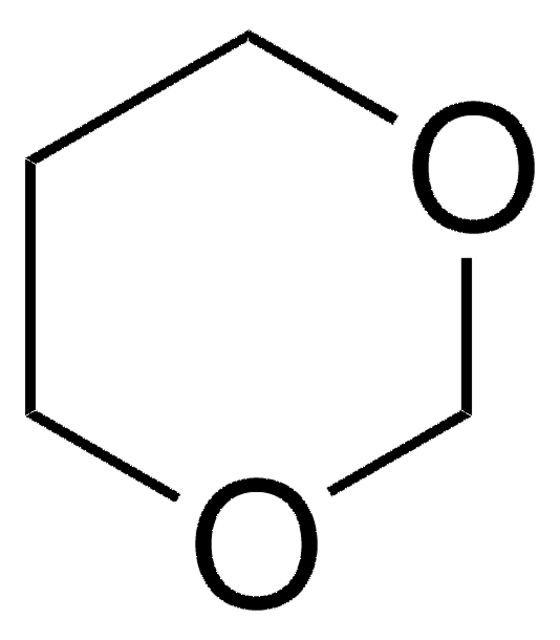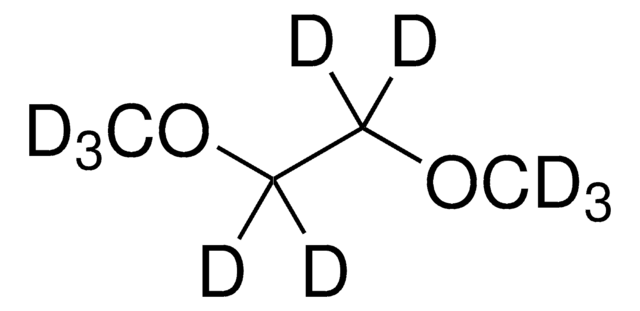271020
1,3-Dioxolane
anhydrous, contains ~75 ppm BHT as inhibitor, 99.8%
Synonym(s):
Ethylene glycol methylene ether, Formaldehyde ethylene acetal
About This Item
Recommended Products
grade
anhydrous
Quality Level
vapor density
2.6 (vs air)
vapor pressure
70 mmHg ( 20 °C)
Assay
99.8%
form
liquid
autoignition temp.
525 °F
contains
~75 ppm BHT as inhibitor
impurities
<0.003% water
<0.005% water (100 mL pkg)
evapn. residue
<0.0005%
refractive index
n20/D 1.401 (lit.)
bp
75-76 °C/1.013 hPa
mp
−95 °C (lit.)
density
1.06 g/mL at 25 °C (lit.)
SMILES string
C1COCO1
InChI
1S/C3H6O2/c1-2-5-3-4-1/h1-3H2
InChI key
WNXJIVFYUVYPPR-UHFFFAOYSA-N
Looking for similar products? Visit Product Comparison Guide
Related Categories
General description
Application
- For the extraction of biodegradable poly(3-hydroxybutyrate) (PHB) from biomass.
- To produce stable dispersions of multiwalled carbon nanotubes (MWCNTs) for the synthesis of modified glassy carbon electrodes.
- To synthesize copolymers (polyoxymethylene) by cationic copolymerization of 1,3,5-trioxane in the presence of maghnite-H+ as a catalyst.
It is also used as a reactant to prepare quasi-solid-state poly(1,3-dioxolane) electrolyte by Sc(OTf)3 catalyzed ring-opening polymerization reactions.
Signal Word
Danger
Hazard Statements
Precautionary Statements
Hazard Classifications
Eye Irrit. 2 - Flam. Liq. 2 - Repr. 1B
Storage Class Code
3 - Flammable liquids
WGK
WGK 1
Flash Point(F)
26.6 °F - closed cup
Flash Point(C)
-3 °C - closed cup
Personal Protective Equipment
Regulatory Listings
Regulatory Listings are mainly provided for chemical products. Only limited information can be provided here for non-chemical products. No entry means none of the components are listed. It is the user’s obligation to ensure the safe and legal use of the product.
FSL
Group 4: Flammable liquids
Type 1 petroleums
Hazardous rank II
Water soluble liquid
ISHL Indicated Name
Substances Subject to be Indicated Names
ISHL Notified Names
Substances Subject to be Notified Names
JAN Code
271020-1L:4548173935416
271020-2L:4548173935423
271020-6X1L:
271020-100ML:4548173935409
271020-BULK:
271020-VAR:
Choose from one of the most recent versions:
Already Own This Product?
Find documentation for the products that you have recently purchased in the Document Library.
Customers Also Viewed
Our team of scientists has experience in all areas of research including Life Science, Material Science, Chemical Synthesis, Chromatography, Analytical and many others.
Contact Technical Service












